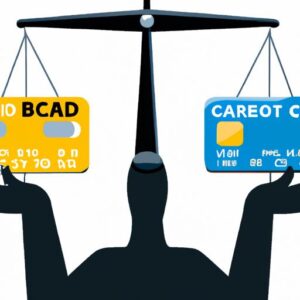Are you struggling to keep up with multiple credit card payments? Are the high interest rates eating away at your hard-earned money? It’s time to take control of your finances and explore the world of interest free balance transfer credit cards. In this article, I will guide you through the ins and outs of these credit cards, their importance in managing your debt, and the incredible benefits they offer.
What is an interest free balance transfer credit card?
An interest free balance transfer credit card is a powerful tool that allows you to transfer your existing credit card debt to a new card with an introductory period of no interest charges. This means that for a certain period, usually ranging from 6 to 24 months, you won’t have to worry about paying any interest on your transferred balance. It’s like hitting the pause button on your interest payments, giving you a much-needed breather to focus on paying off your debt.
Importance of finding the right credit card for balance transfers
Finding the right credit card for balance transfers is crucial to effectively manage your debt. Not all cards are created equal, and choosing the wrong one could leave you with hefty interest charges or unfavorable terms. By selecting a credit card specifically designed for balance transfers, you can take advantage of the interest-free period and save a substantial amount of money in interest payments.
Benefits of an interest free balance transfer credit card
The benefits of an interest free balance transfer credit card are numerous and can significantly impact your financial well-being. Firstly, you can consolidate your credit card debt into one manageable payment, simplifying your finances and reducing the stress of juggling multiple bills. Additionally, the interest-free period gives you the opportunity to make substantial progress in paying down your debt, as every dollar goes directly towards the principal amount. This can accelerate your journey to becoming debt-free and provide you with a fresh start towards financial freedom.
In the upcoming sections, we will delve deeper into the mechanics of balance transfers, guide you in choosing the right credit card, walk you through the application process, and provide expert tips on managing your balance transfer credit card effectively. So, buckle up and get ready to take control of your debt with interest free balance transfer credit cards.
Understanding Balance Transfers
Explaining the concept of balance transfers
Let’s start by demystifying the concept of balance transfers. When you transfer a balance from one credit card to another, you essentially move your existing debt from one account to another. This can be incredibly beneficial if you’re carrying a high-interest balance on your current credit card. By moving your debt to a new card with a lower or 0% introductory interest rate, you can save a substantial amount of money in interest charges.
How interest rates can affect your credit card debt
Interest rates play a crucial role in determining the cost of carrying debt. If you’re currently saddled with a credit card that has a high-interest rate, a significant portion of your monthly payments may be going towards interest charges rather than reducing your principal balance. This can make it challenging to make meaningful progress in paying off your debt.
By opting for a balance transfer to a card with a lower or 0% introductory interest rate, you can redirect more of your payments towards the principal balance. This allows you to pay off your debt faster and save money in the long run.
Advantages of transferring balances to a new credit card
Transferring balances to a new credit card offers several advantages. First and foremost, it can provide you with immediate relief from high-interest payments. During the introductory period, you won’t have to worry about accumulating additional interest on your transferred balance, giving you the opportunity to make significant strides in paying off your debt.
Additionally, consolidating your balances onto one card streamlines your finances. Instead of keeping track of multiple payment due dates and interest rates, you’ll only have to focus on a single payment. This simplification can reduce the chances of missing payments or incurring late fees.
In the next section, we’ll discuss the factors you should consider when choosing the right interest free balance transfer credit card. So, stay with me as we navigate through the intricacies of finding the perfect card for your needs.
Choosing the Right Interest Free Balance Transfer Credit Card
When it comes to finding the perfect interest free balance transfer credit card, it’s essential to consider several factors that align with your financial goals and circumstances. Let’s explore the key aspects to keep in mind when selecting a credit card for balance transfers.
Factors to consider when selecting a credit card for balance transfers
-
Introductory Period: The length of the interest-free period is crucial. Look for cards that offer an extended period, allowing you ample time to pay off your debt without accruing any interest charges.
-
Balance Transfer Fees: Some credit cards may charge a fee for transferring your balance. Consider the fee structure and opt for cards with lower or no balance transfer fees to minimize additional costs.
-
Interest Rates after the Introductory Period: While the introductory period offers respite from interest charges, it’s vital to understand the interest rates that will apply once the period ends. Ensure that the post-introductory rates are reasonable and manageable for your financial situation.
-
Credit Limit: Evaluate the credit limit offered by the card. It should be sufficient to accommodate your existing debt and any additional expenses, while still leaving room for emergencies.
Comparison of different interest free balance transfer credit cards on the market
With numerous credit cards available, it’s essential to compare their features and benefits. Research different providers and their offerings to find the best fit for your needs. Consider factors such as the length of the interest-free period, balance transfer fees, ongoing interest rates, rewards programs, and customer service reputation.
Key features to look for in a credit card
-
Low or No Annual Fee: Look for cards that have minimal or no annual fees to avoid unnecessary expenses.
-
Reward Programs: Some credit cards offer rewards or cashback programs, providing additional value for your spending. Consider your preferences and select a card that aligns with your lifestyle and spending habits.
-
Additional Benefits: Explore the extra perks and benefits offered by the credit card, such as travel insurance, purchase protection, or extended warranties. These can enhance your overall credit card experience and provide added peace of mind.
By carefully considering these factors, comparing different credit card options, and focusing on the key features that align with your financial goals, you can choose an interest free balance transfer credit card that sets you up for success on your debt repayment journey. In the next section, we will guide you through the application process, ensuring you have all the necessary information to increase your chances of approval.
Applying for an Interest Free Balance Transfer Credit Card
Step-by-step guide on the application process
When it comes to applying for an interest free balance transfer credit card, following a step-by-step guide can help streamline the process and increase your chances of approval. Here’s a breakdown of what you need to do:
-
Research and Compare: Start by researching different credit card providers that offer interest free balance transfer options. Compare their terms, interest-free periods, fees, and any additional benefits they may offer.
-
Check Eligibility: Before applying, ensure that you meet the eligibility criteria set by the credit card provider. Factors such as minimum income requirements, credit score, and employment status may play a role in determining your eligibility.
-
Gather Documents: Prepare the necessary documents to complete your application. This typically includes proof of identification, income statements, and details of your existing credit card debt.
-
Fill out the Application: Complete the application form accurately and provide all the required information. Double-check for any errors or omissions before submitting.
-
Submit Application: Once you’ve reviewed your application, submit it through the credit card provider’s online portal or by mail. Keep a copy of your application for future reference.
Necessary documents and requirements
To ensure a smooth application process, it’s essential to have the necessary documents and meet the requirements set by the credit card provider. Some common documents and requirements may include:
-
Proof of Identification: Provide a valid form of identification, such as a passport, driver’s license, or national ID card.
-
Income Verification: Demonstrate your ability to repay the debt by submitting recent income statements, such as pay stubs or tax returns.
-
Existing Debt Details: Include information about your existing credit card debt, such as the amount owed and the credit card provider.
-
Credit History: The credit card provider will typically evaluate your credit history to assess your creditworthiness. Maintaining a good credit score and history can increase your chances of approval.
Tips for increasing your chances of approval
While approval decisions ultimately rest with the credit card provider, there are steps you can take to improve your chances of being approved for an interest free balance transfer credit card:
-
Maintain a Good Credit Score: Pay your bills on time, keep your credit utilization low, and avoid excessive credit applications to maintain a healthy credit score.
-
Pay Off Existing Debt: Reducing your existing credit card debt can demonstrate responsible financial management and make you a more attractive candidate for balance transfer credit cards.
-
Review and Correct Credit Reports: Regularly review your credit reports for any errors or inaccuracies. Dispute and correct any incorrect information before applying for a new credit card.
-
Limit New Credit Applications: Applying for multiple credit cards within a short period can raise concerns for credit card providers. Limit the number of new credit applications to avoid appearing desperate for credit.
By following these steps and tips, you can enhance your chances of being approved for an interest free balance transfer credit card and take a significant stride towards managing your debt effectively.
Managing a Balance Transfer Credit Card
So, you’ve successfully transferred your credit card balances to an interest free balance transfer credit card. Congratulations! Now comes the crucial part: managing your new card to optimize your debt repayment and make the most of the interest-free period. Here are some strategies and tips to help you effectively manage your credit card debt:
Setting a Repayment Plan to Maximize Interest Savings
One of the key advantages of an interest free balance transfer credit card is the opportunity to save on interest charges. To make the most of this benefit, it’s essential to create a repayment plan that maximizes your interest savings. Start by assessing your overall debt and determining a realistic timeline for paying it off. Break down your debt into manageable monthly payments, ensuring you allocate enough funds to cover the entire balance by the end of the interest-free period. By sticking to your repayment plan, you’ll not only save on interest but also build a strong foundation for your financial future.
Avoiding Common Pitfalls and Mistakes
While managing a balance transfer credit card, it’s important to be aware of common pitfalls and mistakes that can hinder your progress. One common mistake is using the new card for additional purchases, which can increase your debt and make it harder to pay off. Remember, the goal is to focus on paying down your transferred balance, so avoid unnecessary spending. Additionally, be mindful of the terms and conditions of your credit card, such as the length of the interest-free period and any balance transfer fees. Stay organized, make your payments on time, and keep track of important dates to avoid any surprises down the line.
Strategies for Effectively Managing Your Credit Card Debt
To effectively manage your credit card debt, consider implementing the following strategies:
-
Budgeting: Create a realistic budget that aligns with your financial goals. Allocate a specific amount towards your credit card payments each month and stick to it.
-
Automated Payments: Set up automatic payments for your credit card to avoid missing due dates and incurring late fees. This will also help you maintain a consistent repayment schedule.
-
Snowball or Avalanche Method: Explore different debt repayment strategies such as the snowball method (paying off smaller balances first) or the avalanche method (paying off high-interest balances first). Choose the approach that works best for your financial situation.
-
Monitor Your Progress: Regularly review your progress and celebrate milestones along the way. Seeing your debt decreasing and your financial goals coming closer will motivate you to stay on track.
Remember, managing your credit card debt requires discipline and commitment. By implementing these strategies and staying proactive, you’ll be well on your way to achieving financial freedom.
In the next section, we’ll conclude our discussion on interest free balance transfer credit cards and summarize the key points we’ve covered throughout this article.
Conclusion
In conclusion, an interest free balance transfer credit card can be a game-changer when it comes to managing your debt and taking control of your financial future. By understanding the concept of balance transfers and the benefits they offer, you can make informed decisions to save money and pay off your debt faster.
Throughout this article, we’ve explored the importance of finding the right credit card for balance transfers. Remember to consider factors such as the interest-free period, fees, and any additional perks or rewards offered by the credit card issuer. By doing so, you can maximize your savings and make the most of your balance transfer experience.
When applying for an interest free balance transfer credit card, be sure to gather all the necessary documents and meet the requirements to increase your chances of approval. Following a strategic plan to manage your balance transfer credit card, including setting a repayment plan and avoiding common pitfalls, will help you stay on track towards financial success.
Remember, responsible credit card usage and debt management are key. While an interest free balance transfer credit card provides a great opportunity to tackle your debt, it’s essential to avoid falling back into old spending habits and accumulating new debt.
So, take the first step towards a debt-free future and explore the world of interest free balance transfer credit cards. With careful consideration, smart financial decisions, and a commitment to managing your debt, you can pave the way to a brighter financial future. Good luck on your journey to financial freedom!





